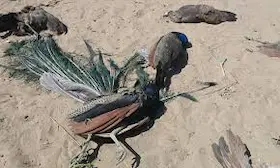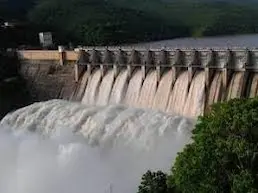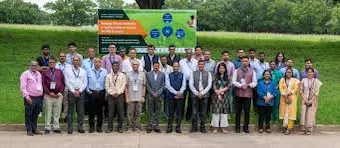1. Bird Deaths in the Thar Desert – Environment

Why in News?
A recent Wildlife Institute of India (WII) study has found that wind farms in the Thar Desert, Rajasthan, have the highest recorded bird mortality rates in the world, raising serious ecological concerns for species like the critically endangered Great Indian Bustard (GIB).
Key Facts & Details
- Survey Area: 3,000 sq. km in Jaisalmer, Rajasthan.
- Turbines Studied: 90 wind turbines.
- Avian Diversity: 272 bird species recorded, including GIB.
- Mortality Estimate: 124 carcasses found within 150m of turbines → ~4,464 bird deaths/year per 1,000 sq. km.
- Control Sites: 28 locations (500–2,000m from turbines) recorded zero deaths — confirming turbines as the cause.
- Comparison:
- 2019 study in Kutch & Davangere → 0.47 bird deaths/turbine/year.
- Current Thar study → 1.24 bird deaths/turbine/month.
- Contributing Factors:
- Thar lies on Central Asian Flyway (major migratory bird route).
- High bird density in the desert ecosystem.
- Collisions with turbines & power lines.
Background & Significance
- Policy Gap:
- No Environmental Impact Assessment (EIA) required for onshore wind projects in India.
- Weak ecological safeguards despite rapid expansion of renewable energy.
- India’s Wind Energy Profile:
- H1 2025: 3.5 GW added (82% YoY growth).
- Total installed capacity: 51.3 GW.
- Potential: 1,163.9 GW at 150m hub height (NIWE data).
- Ecological Stakes:
- Thar is one of the last strongholds for the Great Indian Bustard (critically endangered).
- High mortality could accelerate species extinction.
- Threatens India’s commitments under the Convention on Migratory Species.
Proposed Mitigation Measures
Technological:
- Paint one turbine blade for higher visibility.
- Shutdown during peak migration/high-risk periods.
Planning-Based:
- Site selection is key — avoid high-sensitivity zones.
- Use AVISTEP (Avian Sensitivity Tool for Energy Planning) for mapping bird habitats and risk zones.
Implications & Exam Angles
- Balance between renewable energy targets and biodiversity conservation.
- Need for mandatory EIAs for all renewable energy projects, not just fossil-based plants.
- Integration of scientific tools (AVISTEP) into policy-making for site selection.
Exam Connect – Possible Questions
Prelims
1. Which of the following statements about the Central Asian Flyway is correct?
1. It is one of the nine major flyways for migratory birds recognized globally.
2. It covers the entire Indian subcontinent and parts of Central Asia.
3. The Great Indian Bustard is a species that uses this route.
Select the correct answer:
A.1 and 2 only
B. 1 and 3 only
C. 2 and 3 only
D. 1, 2 and 3
Answer: D. 1, 2 and 3
2. Consider the following statements regarding wind energy in India:
1. India is among the top five countries in installed wind power capacity.
2. Environmental Impact Assessments are mandatory for all onshore wind power projects.
Which of the above is/are correct?
A. 1 only
B. 2 only
C. Both 1 and 2
D. Neither 1 nor 2
Answer: A. 1 only
Mains
1. “The growth of renewable energy in India must not come at the cost of biodiversity loss.” Discuss this statement in the context of wind energy expansion in ecologically sensitive zones like the Thar Desert.
2. Examine the role of tools such as AVISTEP in promoting sustainable energy development while safeguarding critical wildlife habitats in India.
3. Highlight the ecological significance of the Thar Desert and suggest measures to balance renewable energy generation with conservation priorities. challenges posed by renewable energy projects in ecologically sensitive areas, with special reference to the Thar Desert bird mortality case study. Suggest measures to balance biodiversity conservation with India’s renewable energy targets.”
2. Pilibhit Tiger Reserve (PTR) – Environment

Why in News?
An internal survey conducted with the World Wide Fund for Nature (WWF) reports that the tiger population in Pilibhit Tiger Reserve has risen from 71 to about 80 in the past three years, showing effective conservation efforts.
Key Facts & Details
- Location: Districts of Pilibhit, Lakhimpur Kheri, and Bahraich in Uttar Pradesh.
- Area: 730 sq. km → Core zone: 602 sq. km.
- Habitat Types: Dense sal forests, alluvial grasslands, tropical moist & dry deciduous forests, swamp forests.
- Notable Flora: Grass species such as Sacchrum, Sclerostachya, Vetiveria.
- Notable Fauna:
- Flagship species: Tigers (endangered), Swamp deer.
- Birds: Great Hornbill, Bengal Florican.
Geographical & Ecological Significance
- Location Context: Along India–Nepal border at the Himalayan foothills.
- Part of: Terai Arc Landscape – crucial wildlife corridor for large mammals.
- Rivers:
- Origin of Gomti River.
- Catchment area for Sharda, Chuka, Mala Khannot rivers.
- Climate: Dry & hot; supports dry teak forests.
- Soil: Predominantly Vindhya Mountain soils.
Background & Conservation Significance
- Tiger Habitat Importance: PTR is one of the critical tiger habitats under Project Tiger.
- Biodiversity Role: Home to endangered species and grassland-dependent fauna.
- Corridor Connectivity: Ensures gene flow between India and Nepal tiger populations.
- Recognition: Declared as a Tiger Reserve in 2014; winner of the TX2 Award 2020 for doubling tiger population.
Implications & Exam Angles
- Shows success of community engagement & anti-poaching efforts.
- Demonstrates importance of habitat diversity for species conservation.
- Highlights the Terai Arc Landscape as a transboundary conservation priority.
Exam Connect – Possible Questions
Prelims
1. Which of the following rivers originates from the Pilibhit Tiger Reserve?
A. Sharda
B. Gomti
C. Ghaghra
D. Rapti
Answer: D. Rapti
2. Consider the following statements regarding the Terai Arc Landscape:
1.It spans across India and Nepal.
2.It is primarily a desert ecosystem.
3.It serves as an important corridor for tiger movement.
Which of the above statements is/are correct?
A. 1 and 3 only
B. 1 and 2 only
C. 2 and 3 only
D. 1, 2 and 3
Answer: A. 1 and 3 only
Mains
1. “The success of Pilibhit Tiger Reserve in increasing tiger population offers lessons for other protected areas in India.” Discuss the factors responsible for this achievement and their replicability.
2. Examine the ecological and hydrological importance of the Pilibhit Tiger Reserve in the context of the Terai Arc Landscape.
3. How do riverine grasslands contribute to biodiversity conservation? Illustrate with examples from PTR.
3. Sawalkote Hydropower Project – Environment

Why in News?
Months after India suspended the Indus Waters Treaty (IWT), the government has revived the Sawalkote Hydropower Project in Jammu & Kashmir — a plan proposed over 60 years ago but stalled due to treaty restrictions with Pakistan.
Key Facts & Details
- Type: Run-of-the-river hydroelectric project.
- Capacity: 2,185 MW (largest in J&K, among biggest in North India).
- Location: Chenab River, Ramban district, Jammu & Kashmir.
- Estimated Cost: ₹22,704 crore.
- Annual Generation Potential: Over 7,000 million units of electricity.
- Dam Structure: 5-metre roller-compacted concrete gravity dam.
- Implementing Agencies:
- National Hydroelectric Power Corporation (NHPC) Ltd.
- J&K State Power Development Corporation Limited (JKSPDC).
Background & Significance
- Delay Reason: Originally proposed in the 1960s; delayed due to constraints under the Indus Waters Treaty, 1960, which allocated waters of the Chenab, Jhelum, and Indus to Pakistan.
- Strategic Context: Suspension of IWT provisions has opened space for upstream hydropower development on western rivers.
- Energy Benefits:
- Improves winter electricity supply in J&K.
- Potential to make J&K power-surplus and export electricity to the national grid.
- Water Management Benefits:
- Flood mitigation downstream.
- Better regulation of Chenab flow for agriculture & domestic use.
Geographical Context
- Chenab River Origin: From Himachal Pradesh (Baralacha Pass), flows into J&K, then Pakistan.
- Basin Importance: Critical for agriculture, hydropower, and strategic water security.
Implications & Exam Angles
- Strategic: Assertion of India’s rights over western rivers under IWT framework.
- Economic: Boost to J&K’s economy via electricity sales.
- Environmental: Potential ecological impacts on aquatic biodiversity and sediment flow.
- Social: Improved electricity access, but possible resettlement challenges.
Exam Connect – Possible Questions
Prelims
1. Consider the following statements regarding the Sawalkote Hydropower Project:
1.It is located on the Jhelum River.
2.It is a run-of-the-river project.
3.It is being implemented by NHPC in collaboration with JKSPDC.
Which of the above statements is/are correct?
A. 1 and 2 only
B. 2 and 3 only
C. 1 and 3 only
D. 1, 2 and 3
Answer: C. 1 and 3 only
2. With reference to the Chenab River, consider the following:
1.It originates from Himachal Pradesh.
2. It flows through Jammu & Kashmir before entering Pakistan.
3. It is part of the eastern rivers under the Indus Waters Treaty.
Which of the above statements is/are correct?
A. 1 and 2 only
B. 1 and 3 only
C. 2 and 3 only
D. 1, 2 and 3
Answer: A. 1 and 2 only
Mains
1. “The revival of the Sawalkote Hydropower Project is as much a strategic decision as it is an energy project.” Discuss in light of the suspension of the Indus Waters Treaty provisions.
2. Evaluate the potential environmental and socio-economic impacts of large run-of-the-river hydropower projects in Himalayan river basins.
3. How can J&K leverage its hydropower potential to achieve energy self-sufficiency while balancing ecological sustainability?
4. ICRISAT’s AI-based Agromet Advisory Service – Science & Technology

Why in News?
The International Crops Research Institute for the Semi-Arid Tropics (ICRISAT), in collaboration with the Indian Council of Agricultural Research (ICAR), has launched an AI-based Agromet Advisory Service to provide real-time, localized climate advisories to farmers, helping them adapt to climate change.
Key Facts & Details
- Technology Used: Artificial Intelligence (AI) & Machine Learning (ML).
- Purpose: To assist farmers with timely decisions on sowing, irrigation, and pest management.
- Access Channels: User-friendly platforms, including an AI-powered WhatsApp bot.
- Focus Area: Initially rolled out in Maharashtra through ICAR’s Agro-Meteorological Field Units (AMFUs).
- Target Group: Smallholder farmers in climate-vulnerable regions.
Additional Details & Collaborations
- Government Support: Part of Monsoon Mission III.
- Partner Organizations:
- CRIDA-ICAR (Central Research Institute for Dryland Agriculture)
- International Livestock Research Institute (ILRI)
- Indian Institute of Tropical Meteorology (IITM)
- India Meteorological Department (IMD)
- iSAT Tool: Intelligent Systems Advisory Tool, earlier piloted in Monsoon Mission II, now upgraded to an AI-powered advisory platform for converting complex climate data into actionable advice.
Significance
- Climate Adaptation: Helps farmers cope with irregular rainfall, droughts, and extreme weather events.
- Localized Insights: Converts macro climate models into location-specific actionable advice.
- Digital Inclusion: Use of mobile-based and chat-based platforms enables last-mile reach.
- Scalability: Potential to expand nationwide and serve as a global model for agromet advisory.
Implications & Exam Angles
- Integration of AI with agrometeorology marks a shift towards precision agriculture.
- Supports doubling farmer income through reduced crop loss and optimized resource use.
- Could reduce dependency on traditional guess-based farming practices.
Exam Connect – Possible Questions
Prelims
1. The “Intelligent Systems Advisory Tool (iSAT)” recently seen in news is:
A. A blockchain-based system for agri-trade.
B. An AI-powered platform for climate-based agricultural advisories.
C. A drone navigation software for crop spraying.
D. A satellite imaging tool for land-use mapping.
Answer: B. An AI-powered platform for climate-based agricultural advisories.
2. Which of the following institutions are involved in India’s AI-based Agromet Advisory Service?
1.ICRISAT
2.Indian Meteorological Department
3.International Livestock Research Institute
4.Central Research Institute for Dryland Agriculture
Select the correct answer:
A. 1 and 2 only
B.1, 3 and 4 only
C. 1, 2, 3 and 4
D. 2 and 4 only
Answer: C. 1, 2, 3 and 4
Mains
1. “The integration of Artificial Intelligence with agricultural meteorology has the potential to transform climate-resilient farming in India.” Discuss with reference to the ICRISAT Agromet Advisory Service.
2. Examine the role of AI-powered agrometeorological services in improving smallholder farmers’ productivity and climate adaptation capacity.
3. Evaluate the challenges of implementing AI-based advisory tools in rural India and suggest solutions for effective adoption.
5. Central Industrial Security Force (CISF) – Defence & Security

Why in News?
The Union Ministry of Home Affairs (MHA) has approved recruitment of 58,000 additional personnel for the CISF to secure upcoming industrial hubs in areas affected by Left Wing Extremism (LWE).
Key Facts & Details
- Type: Central Armed Police Force (CAPF) under MHA.
- Established: 1969, through the CISF Act, 1968.
- Initial Strength: 3 battalions → Now: 1.88 lakh+ personnel.
- Primary Role: Security for critical infrastructure (airports, nuclear installations, major industries).
Background & Historical Evolution
- 1969: Secured public sector undertakings.
- 1983: Declared an Armed Force of the Union.
- 2000: Took over airport security post IC-814 hijacking.
- Post-2008 Mumbai Attacks: Expanded mandate to include private corporate security (on cost-recovery basis).
Organizational Structure
- Headed by: Director General (IPS).
- Divisions: 7 sectors – Airport, North, North-East, East, West, South, and Training.
- Special Wings: Fire Service Wing, Disaster Management units.
Functions
- Critical Infrastructure Security: Airports, nuclear plants, power plants, refineries.
- Heritage Security: Historical monuments (e.g., Taj Mahal).
- Transport Security: Airports & Delhi Metro.
- Disaster Management: Specialized training for natural and man-made disasters.
- VIP Security: For select high-profile individuals.
Significance in Present Context
- Industrial Expansion: Upcoming industrial hubs in LWE-affected regions require strong security presence.
- Public Interface Role: Unique among CAPFs for constant civilian interaction at metros, airports, monuments.
- Strategic Preparedness: Recruitment will ensure readiness for both traditional and emerging threats.
Exam Connect – Possible Questions
Prelims
1. With reference to the Central Industrial Security Force (CISF), consider the following statements:
1.It was established through an Act of Parliament in 1969.
2.It operates under the Ministry of Defence.
3.It is mandated to secure both public and private sector establishments.
Which of the above statements is/are correct?
A. 1 and 2 only
B. 1 and 3 only
C. 2 and 3 only
D. 1, 2 and 3
Answer: B. 1 and 3 only — Established via CISF Act, 1968 (operational from 1969), under MHA, and secures both public & private assets.
2. Which of the following is/are part of CISF’s mandate?
1.Airport security
2.Disaster response operations
3. Protection of heritage monuments
4.Coastal patrolling
Select the correct answer using the code below:
A. 1 and 2 only
B.1, 2 and 3 only
C. 2, 3 and 4 only
D. 1, 2, 3 and 4
Answer: B.1, 2 and 3 only — CISF is involved in airport security, disaster management, and heritage protection, but not coastal patrolling (done by Indian Coast Guard).
Mains
1. “The expansion of the CISF’s manpower is a proactive step towards securing India’s industrial future.” Discuss in the context of Left Wing Extremism-affected areas.
2. Examine the evolving role of the CISF from public sector security to multifaceted infrastructure and public interface duties.
3. Analyse the challenges faced by CISF in balancing security duties with public-friendly operations at high-footfall locations.
6. Biologics & Biosimilars: The Next Frontier in Affordable Medicines – Science & Technology

Why in News?
The rapid growth of biologics and biosimilars is reshaping modern healthcare. These advanced drugs go beyond traditional small molecule medicines, offering targeted treatments for chronic and complex diseases, while raising debates over affordability and regulation in India.
Key Facts & Details
1. Small Molecule Drugs
- Definition: Low molecular weight, chemically synthesized compounds.
- Features:
- Fixed, chemically stable structure.
- Easier to replicate → generics identical to originals.
- Patent expiry → drastic price drop (e.g., Sovaldi from $84,000 to $1,000).
2. Biologics
- Definition: Large, complex drugs produced from living organisms or cells.
- Examples & Sizes:
- Insulin (~5,800 daltons)
- Remicade (~150,000 daltons)
- Uses: Cancer, autoimmune diseases, hormone therapies.
- Complexity: Minor structural variations possible → manufacturing is intricate.
3. Biosimilars
- Definition: Highly similar versions of biologics (not identical) made after original patent expires.
- Purpose: Affordable alternatives to biologics.
- Difference from generics: Due to complexity, biosimilars require proof of similarity via trials.
Regulatory Landscape
- India: Requires animal + clinical trials → higher costs, longer approval time.
- UK/USA Trends: Reducing animal trials; adopting organ-on-chip & human model testing.
- Reform Need: Waivers for some trials under review in India to reduce cost & speed access.
Significance for India
- Then: Generics revolutionized access to small molecule drugs.
- Now: Affordable biosimilars can expand treatment for chronic, rare, and life-threatening diseases.
- Challenge: Regulatory reform is critical for cost reduction and healthcare expansion.
Implications & Exam Angles
- Affordable biosimilars → reduce healthcare inequality.
- Regulatory reform balances safety and access.
- Opportunity for India to be a global leader in biosimilar manufacturing.
Exam Connect – Possible Questions
Prelims
1. Which of the following best describes a “biosimilar”?
A. An identical chemical copy of a small molecule drug.
B. A near-identical copy of a biologic drug produced after patent expiry.
C. A synthetic vaccine produced in a lab.
D. A herbal formulation with similar therapeutic action.
Answer: B. A near-identical copy of a biologic drug produced after patent expiry.
2. Which of the following statements is/are correct?
1. Biologics are typically of lower molecular weight than small molecule drugs.
2.Biosimilars can be produced without clinical trials in India.
3. Small molecule drugs are easier to replicate compared to biologics.
Select the correct answer:
A. 1 and 2 only
B. 1 and 3 only
C. 3 only
D. 2 and 3 only
Answer: C. 3 only — (1) is wrong (biologics are larger), (2) is wrong (trials required in India), (3) is correct.
Mains
1. “The expansion of biosimilars in India can replicate the success story of generics in improving healthcare access.” Discuss with reference to regulatory and manufacturing challenges.
2. Compare small molecule drugs, biologics, and biosimilars in terms of structure, manufacturing complexity, and regulatory requirements.
3. Examine the role of India in the global biosimilar market and its potential to lead in affordable biologic therapies.

